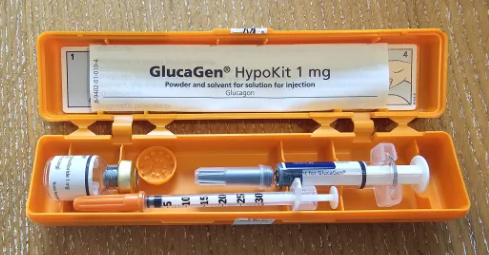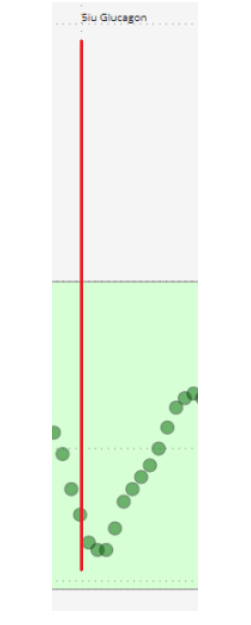Glucagon me… n=1 experiments with microbolusing Glucagon by Tim Street for Diabettech.com, 4-5 April 2023.
Part 1: Setting a Baseline
 Glucagon is a hormone that is produced by the alpha cells and is critical in maintaining glucose homeostasis. It works with the many endocrine hormones to manage glucose, speed of food transit, and liver function, amongst many other things.
Glucagon is a hormone that is produced by the alpha cells and is critical in maintaining glucose homeostasis. It works with the many endocrine hormones to manage glucose, speed of food transit, and liver function, amongst many other things.
Perhaps the most prominent research into Glucagon was undertaken by Roger Unger, who postulated, amongst other things, that Type 1 diabetes is characterized by an excess of glucagon, as there is no mechanism by which it is constrained, due to the lack of beta cells. You could think of this as the liver being a glucose tap, which can never be turned off.
But what of this, and why does it matter here?
There are two parts to this question. The first is that constant glucagon release requires more exogenous insulin to manage it. The second is that if we can cause the liver to release additional glucose from glycogen, then there’s a counter-reaction, whereby the liver needs to reabsorb glucose and convert it back to glycogen.
In theory, if we can counter the first of these, and cause the second, we could increase insulin sensitivity.
Bottom line (from Tim): there’s little to no information about using microbolusing of glucagon in the public domain. The experiment here was to understand what the relationship between insulin on board, glucagon dose and glucose rise looks like, in an n=1 experiment without a huge amount of data. And also to see if there was anything else that needed consideration as a result of this. The answer to above questions is that there does seem to be a relationship, and that some of it is perhaps more complex than we’d think. In general as a population, we probably don’t understand fully the effects of exogenous glucagon
Part 2: Quantifying Use
 Based on what we know about pancreatic activity, the effectiveness of exogenous glucagon will be in proportion to insulin on board, with both hormones acting as switches to the liver. Insulin, however, works with skeletal muscle, so when provided exogenously, has limited effect on the liver. The same skeletal muscle has no glucagon receptors, so glucagon only really affects the liver and the brain. When delivered subcutaneously to various body parts, it mostly affects the liver. The key data being captured was:
Based on what we know about pancreatic activity, the effectiveness of exogenous glucagon will be in proportion to insulin on board, with both hormones acting as switches to the liver. Insulin, however, works with skeletal muscle, so when provided exogenously, has limited effect on the liver. The same skeletal muscle has no glucagon receptors, so glucagon only really affects the liver and the brain. When delivered subcutaneously to various body parts, it mostly affects the liver. The key data being captured was:
- Time to effect – how long before the glucagon dose countered a drop.
Given various literature about intramuscular administration of glucagon, the expectation was that it would take somewhere between 10 and 15 mins for subcutaneous application of glucagon to take effect. This proved to be a reasonable estimate, and indeed, it was possible to observe changes in glucose attributable to glucagon administration in that time frame.
- Size of effect given insulin on board – what positive effect was observed and did it vary with IOB?
Below basal rate and between 100% and 150% of basal rate, the curve worked, however, once the percentage of IOB increased above 150% relative to basal rate, the relationship between the difference became more between expected drop and the level above that that the glucagon maintained. Essentially, where IOB was greater than 150% of basal rate, multiple doses of 5iu of glucagon would be required to stop a hard drop, and there’s a fair bit more work to do to figure out the relationship.
- Unexpected side effects?
Perhaps less surprising than it should have been, using glucagon to handle low levels or the risk of low levels, results in a “hungry liver”. As people with type 1 diabetes, we get used to the liver not trying to convert glucose to glycogen because it doesn’t get any signalling, however, I noticed that my postprandial highs were lower, for a good 12-18 hours after a glucagon dose, as the liver looked to replenish its missing glycogen. Overall, in the alcohol free period, the overall time in range was good, with very low time below range. Is it possible that using glucagon as an additional hormone reduces the sleeping liver effect?
- Effects with and without alcohol.
With alcohol though, the effects were rather different. Given that the Boost algorithm hadn’t been modified to take into account the glucagon dosing, aside from glucagon having no effect when there was alcohol on board (AOB), there was a secondary side effect that it caused lows overnight that I wouldn’t normally see. This appeared when the Boost functionality is disabled and was as a result of standard oref1 function. I essentially became more sensitive overnight than normal.
This came as a bit of a surprise. While I expected that there would be no effects from dosing glucagon with alcohol, I wasn’t expecting some kind of delayed effect. This occurred on multiple occasions so I’m reasonably sure that it was linked to the glucagon administration.
The Takeaway
I think that it’s fair to say that using glucagon to stave off low glucose events is a reasonable approach to using an AID. It does come with some caveats though, namely, it doesn’t work with alcohol, and where IOB is significantly greater than basal rate, it may not have much of an effect, as the liver is shutdown by whatever of the IOB is getting to it, in spite of that being very small levels.
I’d suggest that while it presents promising options, and I can see how it staves off low glucose levels effectively in many circumstances, I’m not sure it’s the answer to everyone’s hopes in the world of type 1 tech. As an adult, there are many cases that would deem it ineffective. I think the major concern is the complete unreliability after alcohol, which is when you’d be most likely to need that safety net.
All of these things present options and I think it’s still possible to improve the management of type 1 with the addition of glucagon in an AID. It’s simply that diabetes is far more complex than two hormones and an algorithm, so while we might make it better, it won’t be perfect.
THANK YOU, Tim Street … another amazing analysis and useful information!
- www.diabettech.com/
- https://www.facebook.com/diabettech/
- https://twitter.com/tims_pants/
Read more:
- Glucagon me… n=1 experiments with microbolusing Glucagon part 1: setting a baseline
- Glucagon me… n=1 experiments with microbolusing glucagon part 2: quantifying use


If only it were it would work. There is no way I would have the patience to figure something like this out. I want my BS down when it is up and up when it is down. No wonder I porpoise some day.